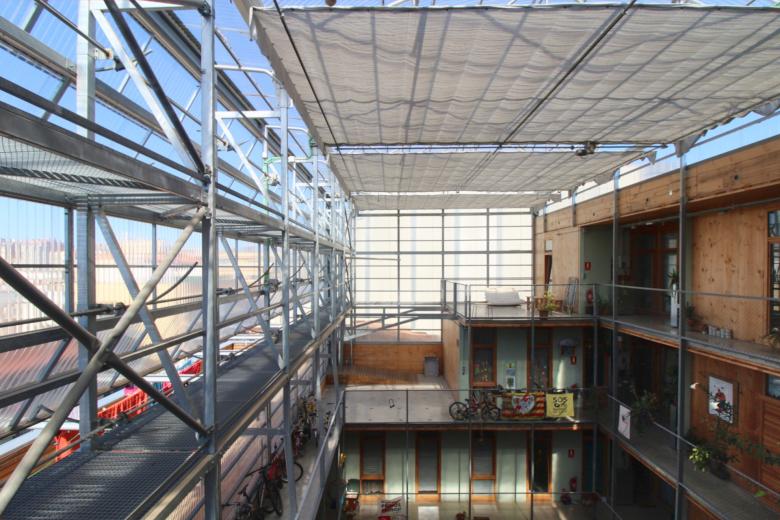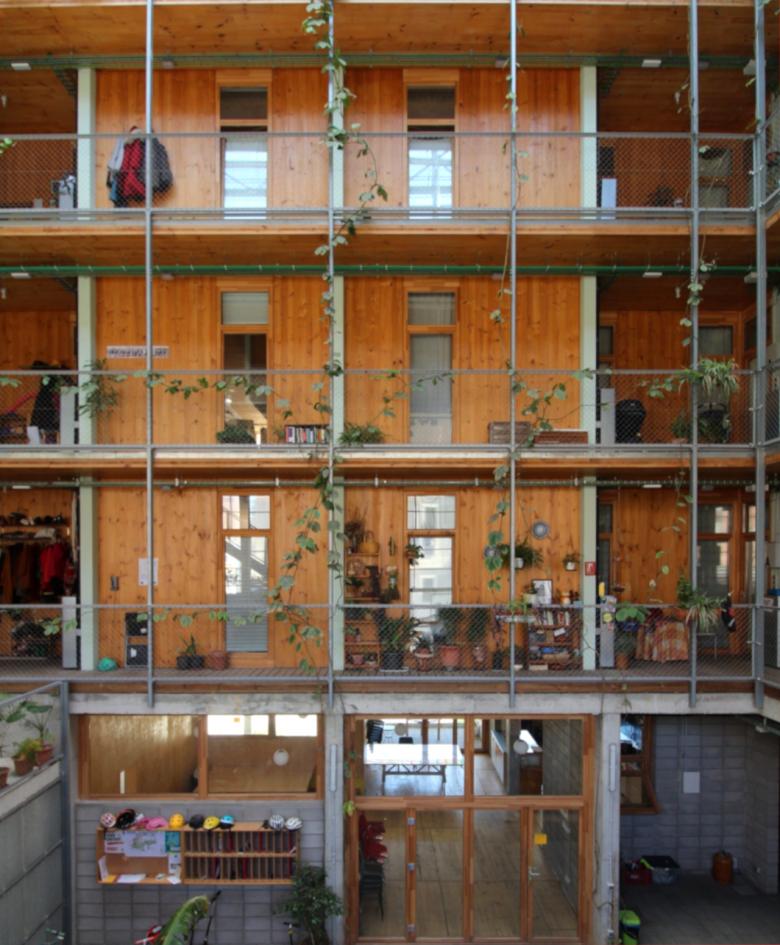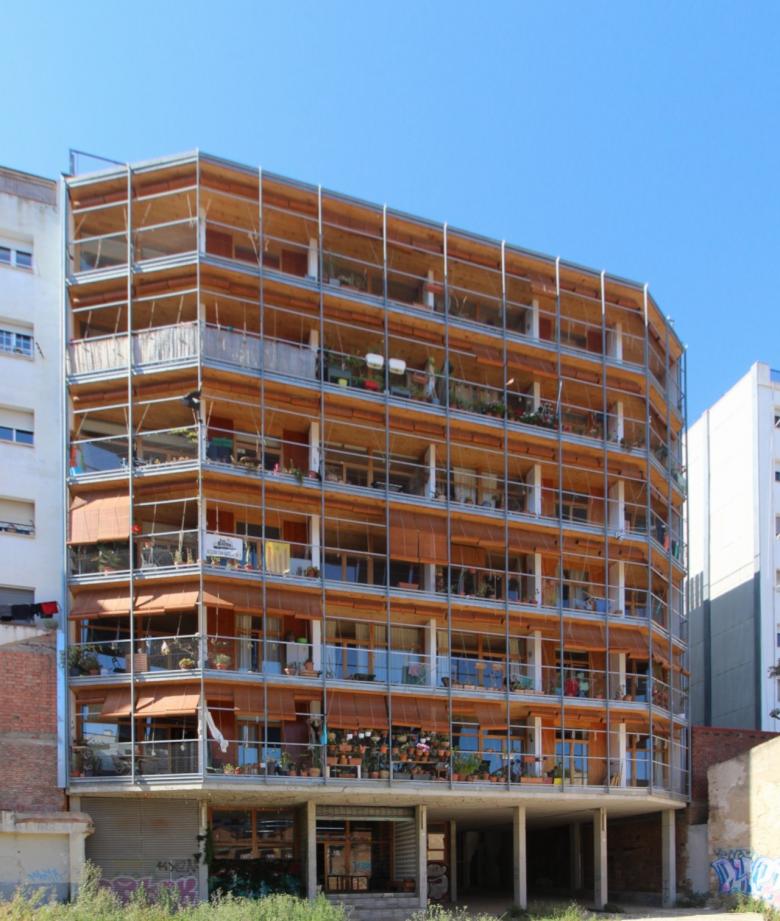La Borda - Cooperative Housing
John Hill, Lacol
16. 5月 2022
All photographs by John Hill/World-Architects
While in Barcelona for EUmies Awards Day, World-Architects got a tour of the La Borda - Cooperative Housing – the Emerging Architecture Winner – from Eliseu Arrufat and Carles Baiges, architects at Lacol, a collaborative office strongly aligned with the mission of La Borda.
Located at Carrer de la Constitució 85, La Borda - Cooperative Housing is situated at a hinge or pivot between two realms: the neighborhood of La Bordeta, where the office of Lacol is found, and the industrial area of Can Batlló, parts of which are being demolished and transformed into luxury housing. La Borda is one of multiple social housing projects in the this Sant are of Barcelona: community-driven projects built on public land. The success of La Borda – there is currently a waitlist to get one of its 28 units – can be grasped in the fact Lacol is currently working on a half-dozen similar projects. That about one-third of the 13 partners in Lacol live in La Borda, and many of the others will move into the new projects once they are done, also attests to the qualities grasped by the jury of the 2022 European Union Prize for Contemporary Architecture – Mies van der Rohe Award.
View of the north facade from Carrer Hartzembusch.
The north facade, on Carrer de la Constitució.
A narrow street, Carrer Hartzembusch, ends directly at the entrance to La Borda. Recognizing the important location and the plans afoot in Can Batlló, the architects at Lacol designed a void into the ground floor, on that will eventually connect La Bordeta on the north to a new park on the south. Once the park is complete the building will act as a portal, basically extending Carrer Hartzembusch through La Borda. Although this aspect of urban design is very forward-thinking, most of the attention of passersby is levied at the north elevation, which has ribbon windows and metal panels that, Arrufat told me, make many people think the building is a school or an industrial building, not housing. Certain parts of the facade, such as the translucent corrugated siding near the base, are stand-ins for later upgrades; that the building is not strictly "done" was evident after getting a tour inside.
Entrance with bike storage.
Looking up at the north side of the atrium.
The entrance off the exterior portal delivers residents into a space that is simultaneously utilitarian and majestic: bike racks sit to one side of the central courtyard, while this central space soars overhead as a full-height atrium through the building's seven floors. Lacol and the client, Habitatges La Borda SCCL, convinced the city of Barcelona to waive a requirement for underground parking since the residents would not be owning cars (common political and environmental views bind the residents of the cooperative); bike parking is provided instead, both at ground level and near the roof. The omission of underground parking reduced the expense of construction and allowed for underground shafts to deliver cool air to the atrium, one part of the comprehensive passive heating/cooling system for the building. From this ground level, one can grasp the basic plan (actual floor plans can be seen here): 24 south-facing units and 4 north-facing units, with common spaces stacked below and/or above them. Also apparent is the structure: one floor at grade framed in concrete, six floors above it framed in wood.
The multi-purpose room on the first floor.
Looking northeast across the atrium toward the multi-purpose room.
The atrium is a comfortable space that does not feel confining for a few reasons: it is not too tall or narrow; the shades at the top bring in lots of filtered natural light (in the winter the shades pull away to help heat this vertical space); and the north side is pierced by a double-height space at the first floor and has a roof lower than the south side. The double-height space is a multi-purpose space for the use of all residents, and on our visit it was set up with couches at one end and children's toys along the north facade. At the opposite end of the couches sat a laundry area, one open to the larger space, just like adjacent storage areas. Baiges explained that the laundry and storage will be closed off at some point in the future.
Looking east across the atrium at the top floor.
The zone between the roof and the shades at the top of the atrium.
More than just a cooperative in social terms, the residents of La Borda need to work together to control the bioclimatic aspects of the buildings. At the level of the individual units this means the "bioclimatic brotherhood" needs to open or close the windows and transoms depending on the season, the weather patterns, and the time of day. Not only is water and other utilities shared equally by all tenants, the comfort of the apartments and the shared spaces depends upon the residents properly stewarding their part of the whole; one unit "out of tune" with the rest has a ripple effect across the building. A place of difference happens at the roof, where the atrium is capped by an industrial greenhouse structure, completed with automated ventilation panels connected to sensors that monitor the climate, weather, and CO2 levels. While the apartments were delivered as raw spaces to be completed by the tenants, extra money was spent up front on this important piece of the building's system of natural ventilation.
The green roof and solar panels above the units on the south end of the building.
Looking south at the context from the roof.
Two of the first add-ons to the project after residents moved in are located on the roof at the south side of the building: a green roof and solar panels. From the roof are views of the evolving Can Batlló area, with new luxury housing jostling against some formerly industrial buildings that are being saved and will be a reminder of the area's past. Directly south of La Borda is land for the future park; although it won't be designed by Lacol, they are fittingly providing participatory input into its design. That park will be linked to further green spaces that will eventually extend to the major spine of Gran Via de les Corts Catalanes, where the luxury housing is located. For the time being, the discover of Roman remains on the site of the green space is delaying construction of the public park.
The south units facing the atrium, with the entrance to the common kitchen-dining at bottom.
Inside the common kitchen-dining space.
If the north street facade is expressive of something else besides housing, the south facade is more classically residential, with generous terraces and roll-down shades. Residents can access the space behind the building through a ground-floor communal kitchen-dining space that has a concrete ceiling but wood floors that are leftover pieces from the CLT structure on the upper floors (these floors, like the green roof, were installed post-occupancy). On our visit, the space was prepping to become the setting for "La Gorda," the weekly cooking group. With the shades up on the south facade at the time of our late-afternoon visit, the lives of the residents were on display through the sight of the plants, tables, and other items occupying the terraces. A similar situation was evident inside, with bookcases, plants, and other furnishings in the walkways overlooking the atrium. Clearly the pioneering residents of this cooperative housing project have made it their own.
The south facade.
The south facade.
Location: Barcelona, Spain
Client: Habitatges La Borda SCCL
Architect: Lacol
- Project Team: Arnau Andrés Gallart, Eliseu Arrufat Grau, Ariadna Artigas Fernández, Carles Baiges Camprubí, Ana Clemente Granados, Eulàlia Daví Borrell, Cristina Gamboa Masdevall, Ernest Garriga Vallcorba, Mirko Gegundez Corazza, Lluc Hernández Torns, Laura Lluch Zaera, Pol Massoni Mangues, Jordi Miró Bover, Núria Vila Vilaregut
Structural Engineering: Miguel Nevado
Technical Architect: AumedesDAP
Consulting: Societat Orgànica, PAuS - Coque Claret & Dani Calatayud
Acoustical: Grisel·la Iglesias
Project Management: José Juan Martínez Larriba
Additional Consultants: La Ciutat Invisible, Holon
Building Area: 3,071 m2














